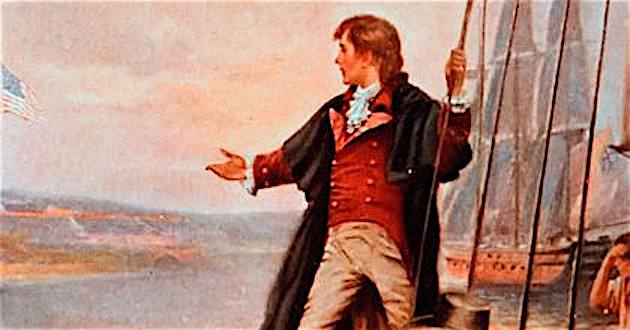As the British attack, Francis Scott Key writes Star Spangled Banner

September 14, 1814 started out as a bad day for the United States of America. That’s the day British soldiers burned the White House and the Capitol Building in Washington, D.C., one of the more scurrilous acts of the War of 1812.
Later that day, British General Robert Ross and Admiral George Cockburn returned to their flagship as it was preparing to depart for Chesapeake Bay where they planned to launch an attack on Ft. McHenry located in Baltimore harbor. The British officers took an American physician, Dr. William Beanes, with them as a prisoner, claiming he was a spy. Upon their arrival in the area a few days earlier, the British officials had established their temporary headquarters in Dr. Beanes’ home in Upper Marlboro.
READ: American History you don’t know, but probably should
The elderly and respected Dr. Beanes was an acquaintance of a well-connected and socially prominent lawyer-poet named Francis Scott Key. As a Federalist and a patriot from a family with anglophile leanings, Key had been philosophically opposed to the idea of going to war with England. But that quickly changed when he became aware of their deliberately malicious act in destroying the U.S. capital. When mutual friends requested his help in getting Dr. Beanes released from British captivity, Key, with his many British connections and access to President James Madison, was only too happy to oblige.
Madison made a sloop available and assigned Colonel John Skinner, a prisoner exchange agent, to accompany Key to the British flagship under a flag of truce that would allow them to safely approach the enemy vessel. When they reached the HMS Tennant, they were received cordially and invited to dine with the Admiral and his staff. Key and Skinner presented their case during which they showed their hosts letters from wounded British prisoners who had good things to say about the care they had received from American doctors including Dr. Beanes.
Eventually, the British officers agreed to release their prisoner but, fearing that Key and Skinner had heard too much about their plans, they said the three Americans could not leave until their attack on Fort McHenry was completed. Key and Skinner had become prisoners themselves and were not too sure about how they would be treated if the British attack was successful. The decision by the British to hold them put Key, perhaps Providentially, exactly where he needed to be in order to produce what would officially became America’s national anthem 117 years later. From the unlikely location on the deck of an enemy ship, he nervously watched the event he would memorialize.

From a few miles away at their anchorage, Key was able to see the Stars and Stripes flying above the fort. The flag they watched all through that night of furious shelling had been specially made at the request of Major George Armistead, commanding officer of Fort McHenry. When requesting the special flag, Armistead said he wanted a flag so big that “the British would have no trouble seeing it from a distance.” The flag he received was a gigantic 42-feet by 30-feet!
As Key, Skinner, and Beanes watched the fort, they kept their focus on that huge flag as best they could through the darkness and smoke. Throughout the night, occasional flashes of “bombs bursting in air” revealed that the “flag was still there.” Their only consolation was that as long as the bombing continued, they knew Major Armistead had not surrendered.
At one point in the middle of the night, the shelling stopped and Key imagined the worst. Later, he learned the shelling had been stopped when a British assault group made up of General Wellington’s regulars had launched an amphibious attack on the fort. It had been repulsed by an assortment of poorly trained but highly motivated Maryland militiamen. When the “dawn’s early light” revealed the flag still flying above Fort McHenry, Key and his party were given their freedom as the British ships prepared to depart in frustration.
Inspired and thrilled by the sight of Armistead’s flag flying above Fort McHenry in the morning breeze and the miraculous nature of what he had just witnessed, Key began to compose his thoughts on the back of a letter he happened to have in his pocket.
Continuing to write while sailing back to Baltimore, he completed The Defence of Fort M’Henry after checking into a hotel. He gave a copy to his brother-in-law, Judge J. H. Nicholson, who quickly had it printed as a handbill. On September 20, it was featured in a Baltimore newspaper. Within a month’s time, it was printed under its new title, The Star Spangled Banner, in newspapers all over the country and performed regularly in public concerts.
Many historians believe it was Nicholson who originally suggested Key’s poem be sung to its now familiar tune of Anacreon in Heaven because the words seemed to fit.
Sometimes described as a British drinking song, it was associated with London’s Anacreontic Society named for a sixth century Greek poet who focused his artistry on love and merry-making. While their members may have done a little drinking, the Society was known as an amateur musical group whose purpose was said to be promoting an interest in music.
Unofficially, The Star Spangled Banner quickly became recognized as the national anthem by many groups, including the military, but it wasn’t proclaimed as such until 1916 when President Woodrow Wilson signed an executive order to that effect.
Finally on March 3, 1931, Congress issued a proclamation, signed by President Herbert Hoover, that made it official: “Be it enacted by the Senate and House of Representatives of the United States of America in Congress assembled, That the composition known as The Star Spangled Banner is designated as the National Anthem of the United States of America.”
In addition to his poetry, Key wrote The Power of Literature and Its Connection with Religion in 1834. As a patriot and Christian, Key observed: “The patriot who feels himself in the service of God, who acknowledges Him in all his ways, has the promise of Almighty direction, and will find His Word in his greatest darkness, ‘a lantern to his feet and a lamp unto his paths.’ He will therefore seek to establish for his country in the eyes of the world, such a character as shall make her not unworthy of the name of a Christian nation.”
Today, the over-sized flag that survived the bombardment of Fort McHenry can be seen at the Smithsonian Institution’s Museum of American History.
–Bob Gingrich is a Kansas City author, historian on the founding of our nation, and Metro Voice contributor.
You can support Metro Voice because we’re an Amazon Affiliate. Learn more about Mr. Gingrich’s book on America’s heritage, other books and resources you might enjoy below.
Check out one of Noah Webster’s most famous books, Advice to the Young.
As an Amazon Affiliate, your browsing helps support Christian journalism.







